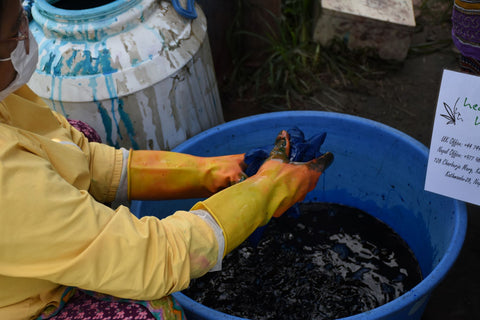
An Introduction to Handmade Paper...
Are you interested in learning more about making tree-free paper by hand? For centuries Nepal has produced it's own handmade paper and still does so today. The raw material used is the bark of the Daphne Cannabina or Daphne Papyracea bush, locally know as ‘Lokta’. As well as other sustainable materials like Cannabis Sativa, commonly known as hemp and Giant Himalayan Nettle locally known as 'Allo'.

What is Archival Paper?
Lokta which generally grows at a certain altitude of 6500-9500 feet produces a higher quality of paper and is known for it's durability and smooth silky texture. And hemp paper is also revered in the paper making world for it's durability and resistance to pests and mold and mildew. If we look into the history of paper many important documents were printed on either hemp, lokta or cotton rag paper and can be classified as archival paper. The paper making process is acid-free which is the reason behind the longevity of the paper and how it retains the colour for centuries, even millenia. The oldest lokta paper document known in Nepal is the sacred Buddhist text called the Karanya Buha Sutra, which introduces the mantra, Om Mani Padme Hum into the sutras. This document has been dated at 1000-1900 years old. Although lokta paper could last for three or even four thousand years.

Worldwide 4 billion trees are cut down every year for paper... The time it takes to grow a tree for it's paper varies from fifteen to fifty years or sometimes even longer for different species of trees to grow as well as depending on the climate they are in. In colder climates like northern Europe or Canada it will take longer to grow than in warmer climates like South America. Whereas to grow the lokta plant and be ready to harvest it for paper will take six to seven years to grow. For each lokta plant harvested it can produce 50-75 sheets of 75x50cm sized paper on average, which is quite impressive for such a small humble shrub. The hemp plant is even more incredible for industrious use like paper making and can be ready to harvest in just four months. Not only that but it can far exceed the amount of paper per acre trees produce; one acre of hemp can give as paper much as 4-10 acres of trees over a span of 20 years.

Harvesting by Hand...
Lokta grows in the wild in the foothills of the Nepal Himalayas. As is tradition villagers will walk to the surrounding hillsides to pick the plant every year. This kind of method of harvesting can be referred to as 'wildcraft' because it is creating a resource from the wild without disruption to the natural eco-system. The way it is harvested means the roots of the plant are not disturbed and neither is the soil allowing the plant to naturally regenerate. Thus preserving the fragile forest ecology of Nepal as well as giving continued work to mountain villages. We at Heaven Hemp believe this adds a great value and certain nobleness to the paper Lokta produces which is generally unmatched by other methods of paper making.
The Process of Paper Making
The way it is produced in Nepal is something of a bygone era, the bark is boiled in a cauldron outside and then beaten with wooden mallets. This produces a soft pulp which is the essence of the paper. The pulp is then spread evenly over a wooden frame floating in a pond of water. The frame is then removed from the water and dried in the Himalayan sunshine, the resulting paper is peeled off the frame.
Here are a series of photos of the making and also dyeing of handmade paper:




